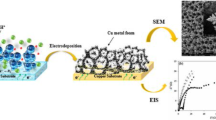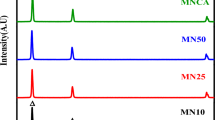Abstract
Nickel–copper metallic foams were electrodeposited from an acidic electrolyte, using hydrogen bubble evolution as a dynamic template. Their morphology and chemical composition was studied by scanning electron microscopy and related to the deposition parameters (applied current density and deposition time). For high currents densities (above 1 A cm−2) the nickel–copper deposits have a three-dimensional foam-like morphology with randomly distributed nearly-circular pores whose walls present an open dendritic structure. The nickel–copper foams are crystalline and composed of pure nickel and a copper-rich phase containing nickel in solid solution. The electrochemical behaviour of the material was studied by cyclic voltammetry and chronopotentiometry (charge–discharge curves) aiming at its application as a positive electrode for supercapacitors. Cyclic voltammograms showed that the Ni–Cu foams have a pseudocapacitive behaviour. The specific capacitance was calculated from charge–discharge data and the best value (105 F g−1 at 1 mA cm−2) was obtained for nickel–copper foams deposited at 1.8 A cm−2 for 180 s. Cycling stability of these foams was also assessed and they present a 90 % capacitance retention after 10,000 cycles at 10 mA cm−2.








Similar content being viewed by others
References
Wang G, Zhang L, Zhang J (2012) A review of electrode materials for electrochemical supercapacitors. Chem Soc Rev 41(2):797–828
Tappan BC, Steiner SA, Luther EP (2010) Nanoporous metal foams. Angew Chem Int Ed 49(27):4544–4565
Erlebacher J et al (2001) Evolution of nanoporosity in dealloying. Nature 410:450–453
Silva RP et al (2012) Fabrication of three-dimensional dendritic Ni–Co films by electrodeposition on stainless steel substrates. J Phys Chem C 116(42):22425–22431
Nikolić ND et al (2006) Morphologies of copper deposits obtained by the electrodeposition at high overpotentials. Surf Coat Technol 201:560–566
Shin H-C, Liu M (2004) Copper foam structures with highly porous nanostructured walls. Chem Mater 16:5460–5464
Shin HC, Dong J, Liu M (2003) Nanoporous structures prepared by an electrochemical deposition process. Adv Mater 15:1610–1614
Nikolić N (2010) Fundamental aspects of copper electrodeposition in the hydrogen co-deposition range. Zaštita materijala 51:197–203
Nikolić ND et al (2006) Phenomenology of a formation of a honeycomb-like structure during copper electrodeposition. J Solid State Electrochem 11:667–675
Tan K, Tian M-B, Cai Q (2010) Effect of bromide ions and polyethylene glycol on morphological control of electrodeposited copper foam. Thin Solid Films 518:5159–5163
Nam D et al (2011) Effects of (NH4)2SO4 and BTA on the nanostructure of copper foam prepared by electrodeposition. Electrochim Acta 56:9397–9405
Cherevko S, Xing X, Chung C-H (2010) Electrodeposition of three-dimensional porous silver foams. Electrochem Commun 12:467–470
Yang G-M et al (2011) Bubble dynamic templated deposition of three-dimensional palladium nanostructure catalysts: approach to oxygen reduction using macro-, micro-, and nano-architectures on electrode surfaces. Electrochim Acta 56:6771–6778
Cherevko S, Chung C-H (2011) Direct electrodeposition of nanoporous gold with controlled multimodal pore size distribution. Electrochem Commun 13(1):16–19
Choi W-S et al (2012) Nanostructured metallic foam electrodeposits on a nonconductive substrate. J Mater Chem 22:1028–1032
Cullity BD (1978) Elements of X-ray diffraction. Addison-Wesley Publishing Company, Boston
Pourbaix M (1974) Atlas of electrochemical equilibria, 2nd edn. National Association of Corrosion Engineers, Houston
Brenner A (1963) Electrodeposition of alloys principles and practice. Academic Press, San Diego
Mattsson E, Bockris JM (1959) Galvanostatic studies of the kinetics of deposition and dissolution in the copper + copper sulphate system. Trans Faraday Soc 55:1586–1601
Gabrielli C et al (2004) Mechanism of copper deposition in a sulphate bath containing chlorides. J Electroanal Chem 572:367–375
Soares DM et al (2002) Copper ion reduction catalyzed by chloride ions. J Electroanal Chem 532:353–358
Shao W, Pattanaik G, Zangari G (2007) Influence of chloride anions on the mechanism of copper electrodeposition from acidic sulfate electrolytes. J Electrochem Soc 154:D201–D207
Epelboin I, Joussellin M, Wiart R (1981) Impedance measurements for nickel deposition in sulfate and chloride electrolytes. J Electroanal Chem 119:61–71
Oriňáková R et al (2006) Recent developments in the electrodeposition of nickel and some nickel-based alloys. J Appl Electrochem 36:957–972
Saraby-Reintjes A, Fleischmann M (1984) Kinetics of electrodeposition of nickel from watts baths. Electrochim Acta 29(4):557–566
Santana AIC et al (2009) A kinetic study on nickel electrodeposition from sulfate acid solutions. J Electrochem Soc 156:D326–D330
Chakrabarti DJ et al (1992) Cu–Ni (copper–nickel) phase diagram. In: Metals handbook, vol. 3: alloy phase diagrams. ASM International, Russel
Conway BE (1999) Electrochemical supercapacitors: scientific fundamentals and technological applications. Kluwer Academic, New York
Yau S-L et al (1994) In situ scanning tunneling microscopy of Ni (100) in 1 M NaOH. J Phys Chem 98(21):5493–5499
Hu C–C, Chang K-H, Hsu T-Y (2008) The synergistic influences of OH− concentration and electrolyte conductivity on the redox behavior of Ni(OH)2/NiOOH. J Electrochem Soc 155(8):F196–F200
Medina AMCLd, Marciano SL, Arvia AJ (1978) The potentiodynamic behaviour of copper in NaOH solutions. J Appl Electrochem 8:121–134
Ismail K, Fathi A, Badawy W (2004) The influence of Ni content on the stability of copper–nickel alloys in alkaline sulphate solutions. J Appl Electrochem 34(8):823–831
Bard AJ, Faulkner LR (2001) Electrochemical methods fundamentals and applications. Wiley, New York
Meher SK, Justin P, Ranga Rao G (2011) Nanoscale morphology dependent pseudocapacitance of NiO. Influence of intercalating anions during synthesis. Nanoscale 3(2):683–692
Menshykau D, Compton RG (2008) The influence of electrode porosity on diffusional cyclic voltammetry. Electroanalysis 20(22):2387–2394
Wu M-S et al (2007) Electrodeposition of nanoporous nickel oxide film for electrochemical capacitors. Int J Hydrogen Energy 32(17):4153–4159
Acknowledgments
The authors would like to acknowledge financial support from Fundação para a Ciência e Tecnologia (FCT) under the project PTDC/CTM-MET/119411/2010 “Electrodeposition of oxide spinel films on stainless steel substrates for the development of new electrodes for supercapacitors”, COST Action MP1004-“Hybrid Energy Storage Devices and Systems for Mobile and Stationary Applications” and COST Action MP1106-“Smart and green interfaces—from single bubbles and drops to industrial, environmental and biomedical applications”
Author information
Authors and Affiliations
Corresponding author
Rights and permissions
About this article
Cite this article
Eugénio, S., Silva, T.M., Carmezim, M.J. et al. Electrodeposition and characterization of nickel–copper metallic foams for application as electrodes for supercapacitors. J Appl Electrochem 44, 455–465 (2014). https://doi.org/10.1007/s10800-013-0646-y
Received:
Accepted:
Published:
Issue Date:
DOI: https://doi.org/10.1007/s10800-013-0646-y




